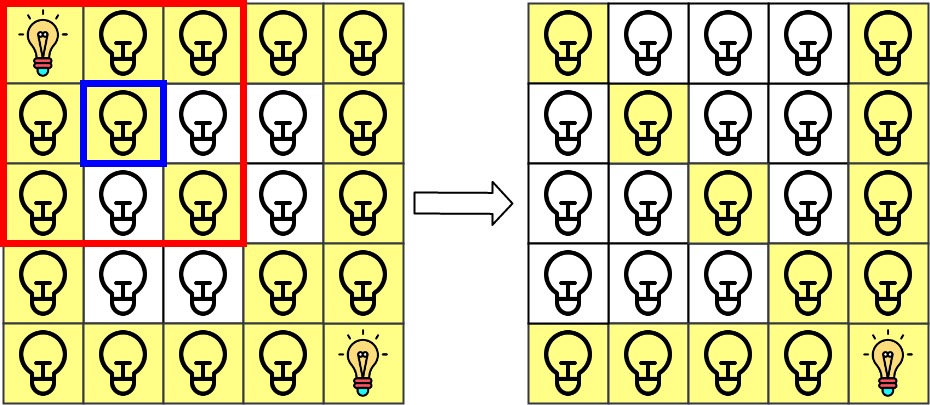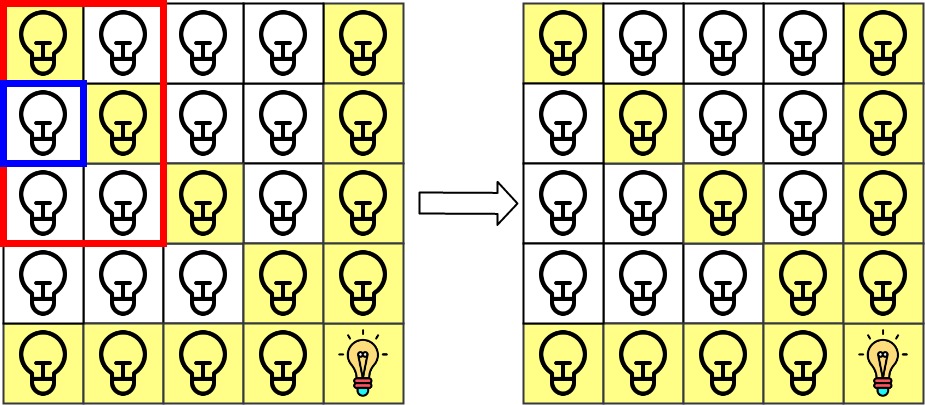LeetCode in Kotlin
1001. Grid Illumination
Hard
There is a 2D grid of size n x n where each cell of this grid has a lamp that is initially turned off.
You are given a 2D array of lamp positions lamps, where lamps[i] = [rowi, coli] indicates that the lamp at grid[rowi][coli] is turned on. Even if the same lamp is listed more than once, it is turned on.
When a lamp is turned on, it illuminates its cell and all other cells in the same row, column, or diagonal.
You are also given another 2D array queries, where queries[j] = [rowj, colj]. For the jth query, determine whether grid[rowj][colj] is illuminated or not. After answering the jth query, turn off the lamp at grid[rowj][colj] and its 8 adjacent lamps if they exist. A lamp is adjacent if its cell shares either a side or corner with grid[rowj][colj].
Return an array of integers ans, where ans[j] should be 1 if the cell in the jth query was illuminated, or 0 if the lamp was not.
Example 1:

Input: n = 5, lamps = [[0,0],[4,4]], queries = [[1,1],[1,0]]
Output: [1,0]
Explanation: We have the initial grid with all lamps turned off. In the above picture we see the grid after turning on the lamp at grid[0][0] then turning on the lamp at grid[4][4]. The 0th query asks if the lamp at grid[1][1] is illuminated or not (the blue square). It is illuminated, so set ans[0] = 1. Then, we turn off all lamps in the red square.  The 1st query asks if the lamp at grid[1][0] is illuminated or not (the blue square). It is not illuminated, so set ans[1] = 0. Then, we turn off all lamps in the red rectangle.
The 1st query asks if the lamp at grid[1][0] is illuminated or not (the blue square). It is not illuminated, so set ans[1] = 0. Then, we turn off all lamps in the red rectangle. 
Example 2:
Input: n = 5, lamps = [[0,0],[4,4]], queries = [[1,1],[1,1]]
Output: [1,1]
Example 3:
Input: n = 5, lamps = [[0,0],[0,4]], queries = [[0,4],[0,1],[1,4]]
Output: [1,1,0]
Constraints:
1 <= n <= 1090 <= lamps.length <= 200000 <= queries.length <= 20000lamps[i].length == 20 <= rowi, coli < nqueries[j].length == 20 <= rowj, colj < n
Solution
class Solution {
fun gridIllumination(n: Int, lamps: Array<IntArray>, queries: Array<IntArray>): IntArray {
val rowIlluminations: MutableMap<Int, Int> = HashMap()
val colIlluminations: MutableMap<Int, Int> = HashMap()
val posDiagIlluminations: MutableMap<Int, Int> = HashMap()
val negDiagIlluminations: MutableMap<Int, Int> = HashMap()
val lampPlacements: MutableSet<Long> = HashSet()
for (lamp in lamps) {
val row = lamp[0]
val col = lamp[1]
var key = row.toLong()
key = key * n + col
if (lampPlacements.contains(key)) {
continue
}
incr(rowIlluminations, row)
incr(colIlluminations, col)
incr(posDiagIlluminations, row + col)
incr(negDiagIlluminations, row + (n - 1 - col))
lampPlacements.add(key)
}
val ans = IntArray(queries.size)
for (i in ans.indices) {
val row = queries[i][0]
val col = queries[i][1]
if (rowIlluminations.containsKey(row) ||
colIlluminations.containsKey(col) ||
posDiagIlluminations.containsKey(row + col) ||
negDiagIlluminations.containsKey(row + (n - 1 - col))
) {
ans[i] = 1
}
val topRow = 0.coerceAtLeast(row - 1)
val bottomRow = (n - 1).coerceAtMost(row + 1)
val leftCol = 0.coerceAtLeast(col - 1)
val rightCol = (n - 1).coerceAtMost(col + 1)
for (r in topRow..bottomRow) {
for (c in leftCol..rightCol) {
var key = r.toLong()
key = key * n + c
if (lampPlacements.contains(key)) {
decr(rowIlluminations, r)
decr(colIlluminations, c)
decr(posDiagIlluminations, r + c)
decr(negDiagIlluminations, r + (n - 1 - c))
lampPlacements.remove(key)
}
}
}
}
return ans
}
private fun incr(map: MutableMap<Int, Int>, key: Int) {
map[key] = map.getOrDefault(key, 0) + 1
}
private fun decr(map: MutableMap<Int, Int>, key: Int) {
val v = map.getValue(key)
if (map[key] == 1) {
map.remove(key)
} else {
map[key] = v - 1
}
}
}

